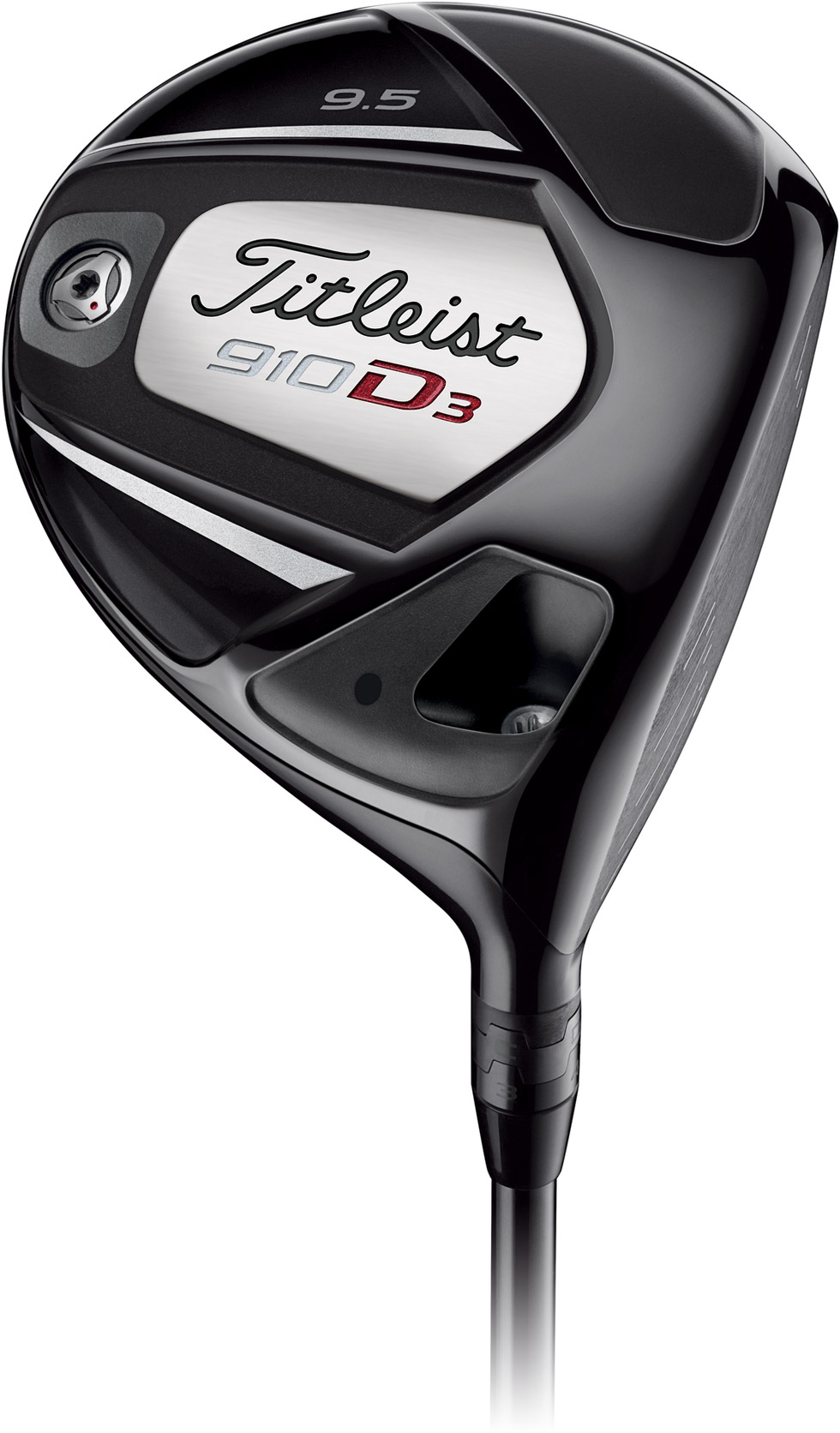 In the past several years, my “gamer” drivers have ranged from the TaylorMade r7 425 TP to the Callaway FT-3, various Titleist drivers, and last year, the Mizuno MP-630 Fast Track. Though I was always happy with the 909D3 I owned, the MP-630 gave me just a little more pop and fit a swing I’d worked to improve a little.
In the past several years, my “gamer” drivers have ranged from the TaylorMade r7 425 TP to the Callaway FT-3, various Titleist drivers, and last year, the Mizuno MP-630 Fast Track. Though I was always happy with the 909D3 I owned, the MP-630 gave me just a little more pop and fit a swing I’d worked to improve a little.
But I’ve always appreciated Titleist’s clubs, and found their drivers largely under-appreciated, so I was excited to give the 910D3 a try. The club shipped in November, making for a great Christmas present for many, and after extensive testing I’m happy to share my thoughts on Titleist’s first customer-adjustable driver.
Read on to see what I thought of this all-black driver.
Design and Technology
Titleist had success with the 905 series of drivers (particularly the 905R). The 907 series followed and was moderately successful. Then we saw the 909 series, a step in the right direction after the 907 series couldn’t supplant the 905R in the bags of many players, on the PGA Tour or otherwise.
The 910 series driver is here, and with it, the new SureFit Tour (SFT) dual-angle hosel. This allows for the loft and lie to be adjusted independently of one another – the first capable of that functionality. With most other adjustable clubs on the market, there is a trade off – as you open a club, the loft is reduced, and as it is closed, the loft increases. The new SFT Technology has no such restrictions.
The new 910D2 and 910D3 are not only the highest performing drivers in the history of the Titleist golf club franchise, but represent a true competitive advantage in driver performance and fitting. The ability to independently adjust loft and lie allows ball flight to be optimized both high and low, and for more fade or draw.
Dan Stone, Vice President of Research and Development, Titleist Golf Clubs
Continuing their model of previous years, Titleist released two variations of the 910; a larger 910D2 which features a 460cc head and a 910D3, which is slightly smaller at 445cc. The larger pear-shaped head of the D2 was designed for maximum forgiveness and playability, and works to reduce side spin, thereby producing a straighter shot with a higher launch. The 910D3 on the other hand, was designed to promote a lower, boring, more penetrating ball flight, and is said to be more workable. Noticeably absent is the “DComp” model. While the 909DComp used a composite crown to move weight lower and deeper, thus improving the location of the center of gravity. The 910 series drivers do the exact same thing, though via the use of ultra-thin casting technology, which produces a thinner titanium crown. More simply put, it was unneeded due to an overlap in functionality and purpose.
The new 910 drivers provide improvements in flight, fit, looks, feel and sound, and provide a new level of precision fitting to deliver total performance and driving confidence. Together, these advances put the Titleist 910 drivers in a class of their own, both on Tour and in the marketplace.
Steve Pelisek, General Manager, Titleist Golf Clubs
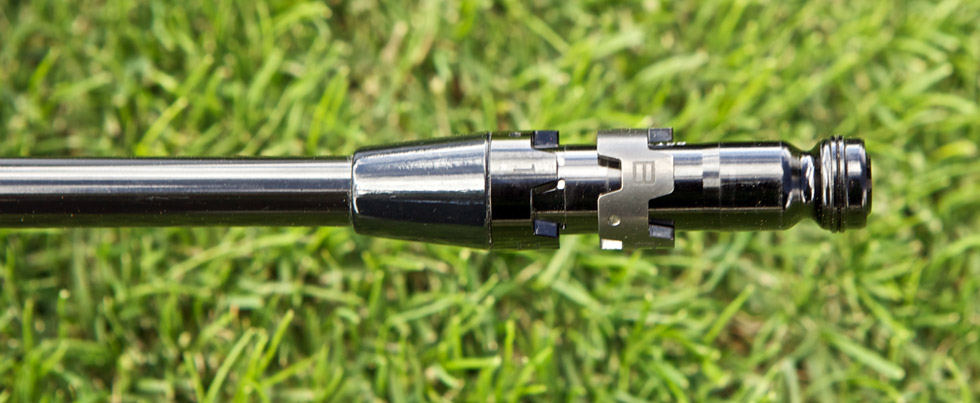
The SFT hosel is composed of a sleeve and a pair of rings, each of which allow for four independent settings. The first ring’s settings are labeled 1, 2, 3, and 4 and the second is labeled A, B, C, and D. This allows for a total of 16 combinations of loft and lie. It is these two moving parts that allows loft modification independently of lie angle modification. This results in a club that can allow players to easily dial in the optimal setting for their swing, helping them produce the ideal spin and launch conditions while also favoring a left or right ballflight.
We describe SureFit Tour technology as a “Tour Van-in-a-hosel,” because the dual-angle hosel technology in combination with the interchangeable shaft and rear bezel weight provides a fitter with all the power of a tour van right at the point of fitting. We can adjust loft and lie, as well as change the shaft and weight of the driver right on the tee.
Steve Pelisek
Adds Dan Stone:
Previous to the new 910, our fitters on Tour would have to run back and forth to the Tour Van when we needed to adjust the loft and lie of a driver, change a shaft or build an entirely new club. Not anymore. Whereas it would take anywhere from several hours to a full day to fit and build new drivers for a player, with the 910 high performance heads and SFT technology we can now fit them in 30 minutes and they walk off the range with a more precisely fit driver
Dan Stone
There are other notable qualities of the new 910 that cannot be overlooked. Both the 910D2 and 910D3 have a variable thickness face with a thicker central region that is position so that it is equidistant from all points around the perimeter of the face. The result of this face design is a sweet spot in the 910D2 that is 15% larger (910D3 is 10% larger) than that of the 909 series drivers. This means you’re going to get more consistent, more explosive distances, even on off-center contact.
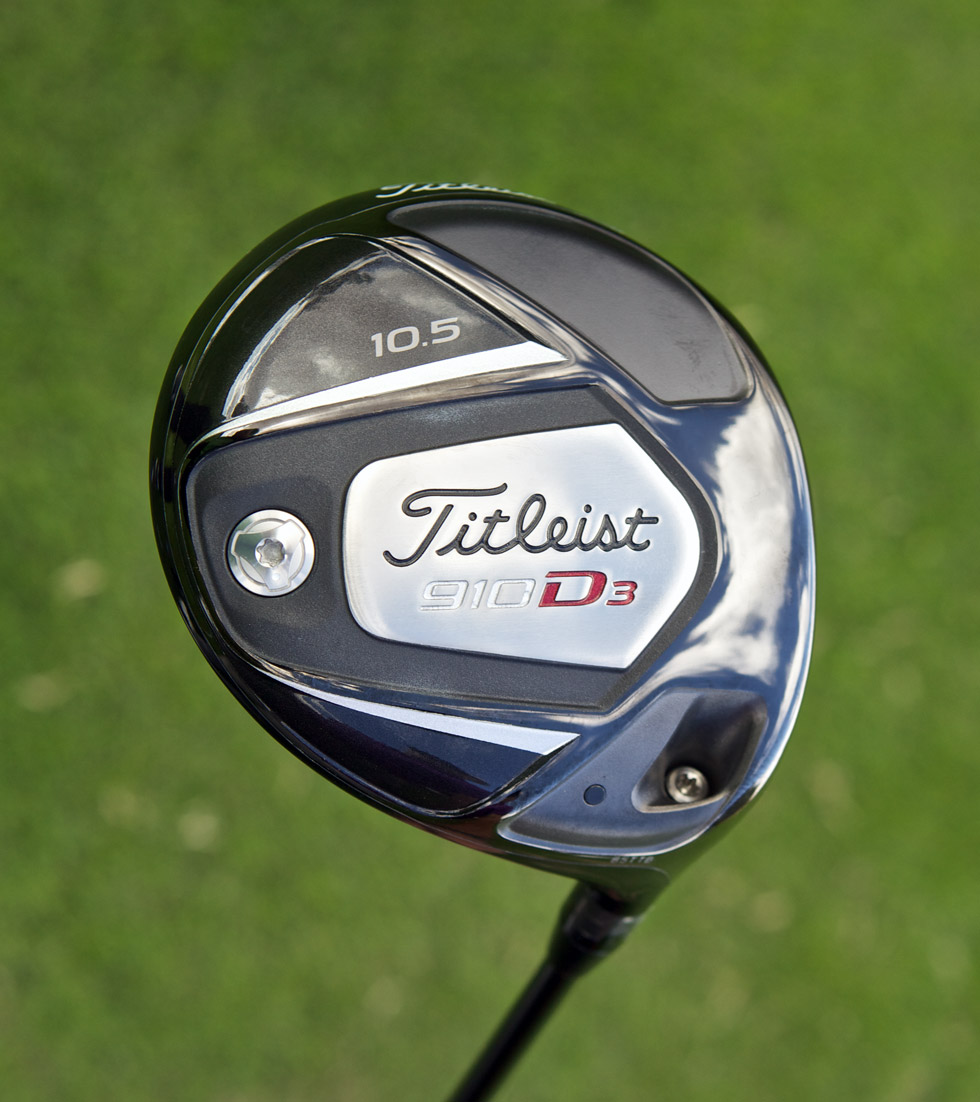
Thanks to their ultra-thin casting technology, Titleist was able to reduce the thickness of the crown by 17%, allowing for that weight to be redistributed back and deep, ultimately leading to greater stability. The aft region of the crown has also undergone modification from that of the 909, sloping lower than before. This compliments the weight redistribution mentioned above, by helping to push the center of gravity down and further back. Helping to take this concept one step further is the relocation of the proprietary rear bezel weight. By taking it lower and deeper, and locating it on axis with the center of the club face, the CG is further optimized, and speed and stability are further promoted.
Both sound and feel were not neglected – in fact both were enhanced to deliver a hotter, more solid sound upon impact. Complimenting that sound and feel is a familiar shaped head, coated in an attractive, black PVD finish and topped off with white score lines that breed confidence.
I tested a 910D3 driver with 10.5° loft, a standard length and lie, and the Mitsubishi ‘ahina 72 X-flex shaft. My default settings were B1 – no loft adjustment and a lie angle 0.75° flat.
Esthetics
I’ve always liked an all-black driver. They look good to me – quietly powerful and subdued – and I’m not entirely sure I buy into the “white is easier to align” stuff that some other companies are trying to sell…
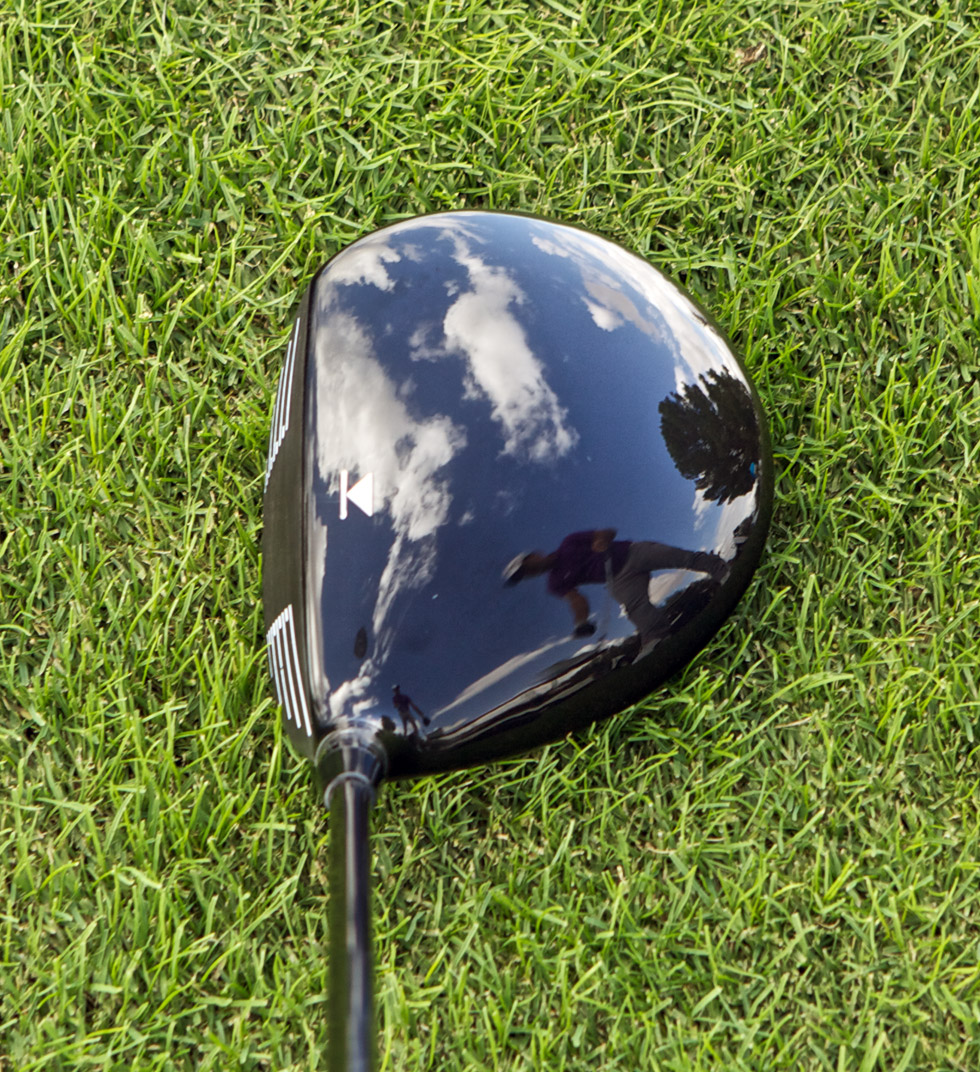
The 910D3 is an all-black driver and it looks great. The shaft, the hosel, the clubface, the crown – all black, all sleek. The crown is adorned with the long-time standard “triangle/bar” alignment aid. The face is devoid of grooves (or paint) in the center of the clubface but alignment lines (it’s tough to call them grooves) towards the toe and heel are set in a high-contrast white.
The toe is the home to the “Titleist” scripted logo, and the sole is plain in terms of letters and numbers: the loft is written in grey towards the toe with “Titleist” and “910D3” on the sole in black, silver, and a dark red. The sole has some lines, triangles, a circular weight port, and the underside of the hosel attachment but is simple, dark, and cohesive.
The SureFit Tour hosel features a three-tone black, silver, and dark grey appearance that shows each separate piece without appearing startlingly different from each other.
The entire design comes together to present a club that’s simply dark. If it’s your cup of tea, you’ll love how the club looks, both on the rack and sitting behind a poor little golf ball. Slazenger may have advertisements with a bloody golf ball and a black panther, but the Titleist 910 could be substituted into that commercial and be a perfect fit.
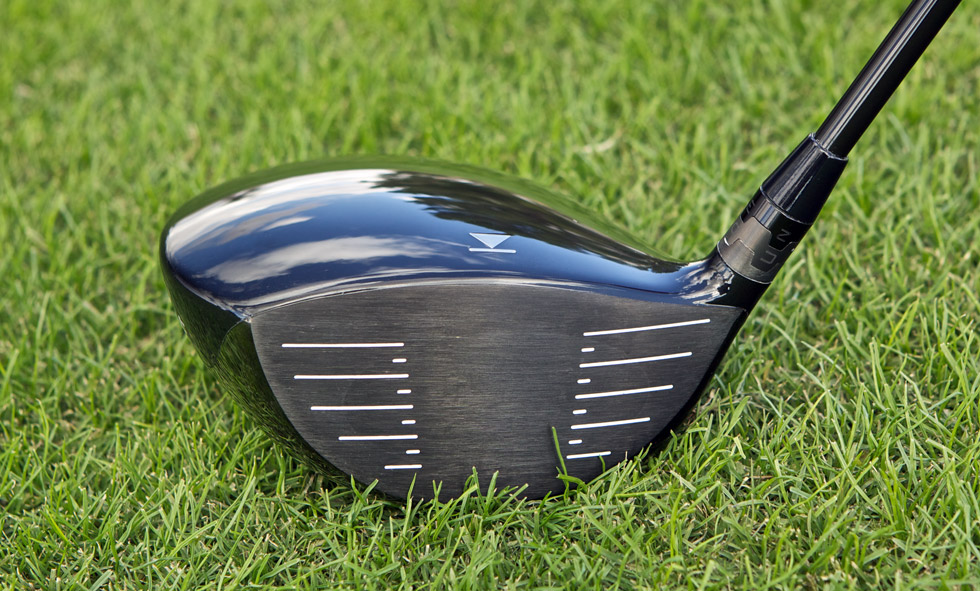
Performance
The Titleist 910D3 will not allow you to drive the ball 30 yards farther than a properly fit driver from four years ago. It will not let you control the ball more than a properly fit driver from four years ago. It will not enhance your sex life, it may enhance the jealousy of your friends, and it will not – on its own – lower your scores.
What the Titleist 910D3 driver can do – admittedly a few years after drivers from other manufacturers – is allow you to buy a club that’s “pretty close” to what you want and to fine-tune it to suit your needs.
The 16-position fitting that the 910 offers could conceivably offer dramatic differences in ball flight and distance. With 2.25° of independent lie angle and loft angle adjustment, the 910 drivers achieve the goal of “a Tour van in a hosel.” Additionally, a golfer could conceivably buy a SureFit Tour hosel shaft and easily create a system with not only 16 positions, but two or three interchangeable driver shafts, depending on conditions, how they were feeling that day, or more.
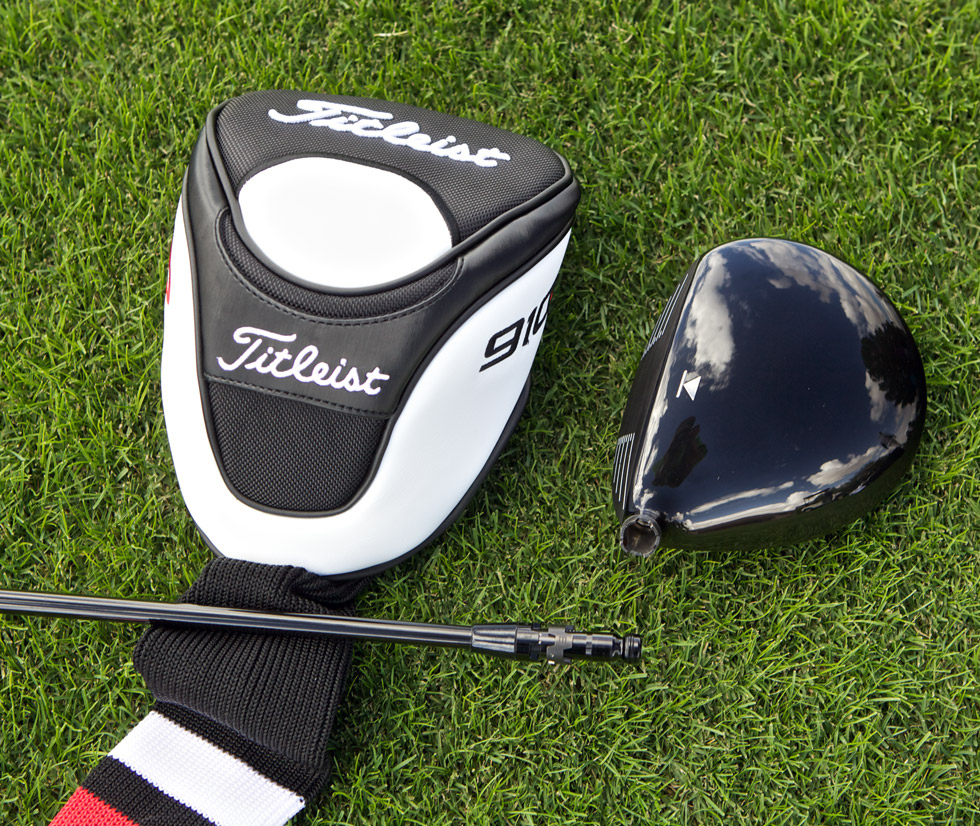
My standard driver swing clocks in at about 110 MPH, so I opted for the x-flex ‘ahini. I’ve recently added loft to my drivers as my angle of approach is fairly level, and the added loft helps to get my launch angle up.
Though many of the adjustable-hosel drivers I’ve tested have felt just a little dead at impact – as if the added weight and “machinery” in the hosel was dampening the feel for the ball transmitted up the shaft and to my hands – I found that the Titleist driver felt surprisingly good at impact. It still seemed to lack a little of the feel from a traditional glued-in, bore-through hosel, but I think that’s to be expected and it’s barely enough to warrant a mention.
I’ve always liked the sound Titleist drivers make, and the 910 is no different. While some drivers sound hollow, tinny, pingy, or otherwise dull, the 910D3 offers an authoritative deep crack that sounds powerful without sounding springy. The pitch differs noticeably though not substantially as contact is made on different parts of the face, which help to let the golfer know exactly where contact was made.
Though I didn’t often adjust my driver from B1 (I chose B1 as I prefer a flatter “left-proof” driver for a push-draw pattern), the times I did the results were as expected. While some companies want to tout “75 yards of sideways adjustability” (or whatever), the Titleist 910 makes no such claims because – gasp – good players tend to adjust their aim, handle position, and swing just a little based on what they see at address.
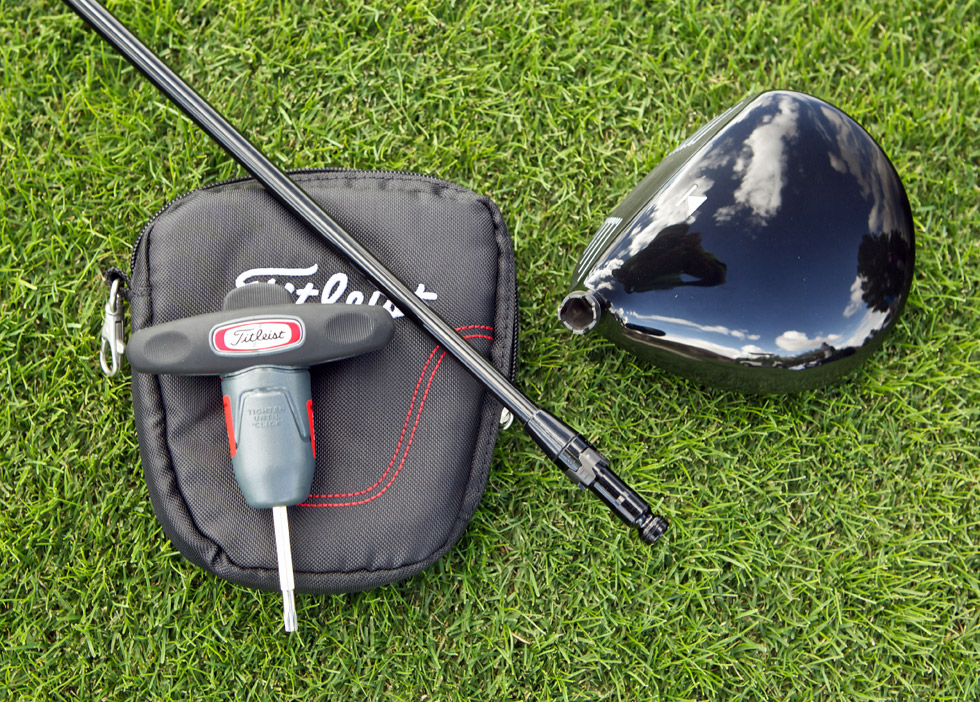
The only way we could figure to test this was a sort of blind setup, wherein I handed the club to someone, he adjusted the hosel, and handed it back to me. I swung without looking at the hosel or at the clubface much at setup, trying to produce a standard swing each time. In this case, and though I’m certainly no robot, the results did manage to demonstrate a moderate amount of adjustability, most noticeably in loft and launch angle. With the lower lofts I lost about 20 yards of carry and 12 yards in total distance, and with the higher lofts I lost four yards of carry distance and eight yards total. The middle lofts produced the best carry and a good amount of run-out.
The lie angle adjustments also proved to work, though not as much because adjusting the lie angle of a clubface with only about 10 degrees of loft is not going to do much. Over the past several years drivers have tended to go steeper with their lie angles because, when a club that’s too steep is returned flatter at impact, the clubface will point ever so slightly to the left – just as the clubface on a wedge points noticeably left when the ball is above your feet. It’s a subtle trick manufacturers have been playing to help the average slicer, but I don’t care for it. Note that the stock position is A1 – you can go more upright twice but only go flatter – to B1 – one position.
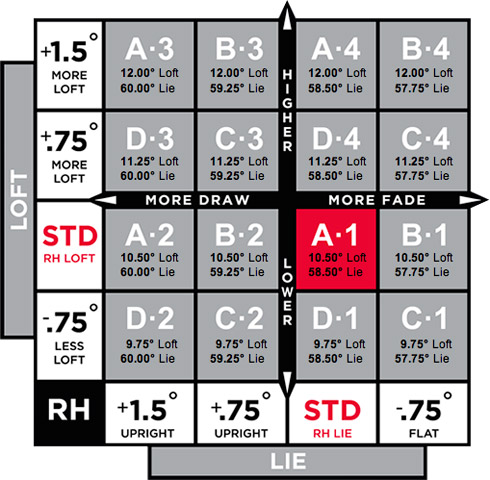
Titleist’s adjustments chart for a driver with 10.5 degrees loft. I used position B1 most.
Long story short, if I maintained the same setup position and tried to swing through without raising the handle more than normal, a more upright lie angle will produce a shot that starts slightly more to the left (a degree or two) and with more “draw spin” or less “fade spin” depending on your stock shot.
As a brief aside, I’m not a fan of the grid Titleist gives you. The numbers count from the lower right-quadrant while the letters count from the upper left quadrant. Why? I think it would have been less confusing to simply label ABCD along one axes and 1234 along the other. The stock position might be named “C3″ instead of A1,” but the chart would have made more sense overall. Currently, C3 is more similar to A1 than C1 and A3 is as similar to C4 as it is to A1.
The shaft I chose is a lower launching shaft, and a heavier one at that, and combined nicely to work with my swing dynamics. I felt that I could go after the ball as much as I wanted and not lose control of the clubhead or need to time anything as the clubhead whipped around. Launch conditions (spin, ball speed, launch angles) were pretty much spot on, particularly after switching from A1 to B1.
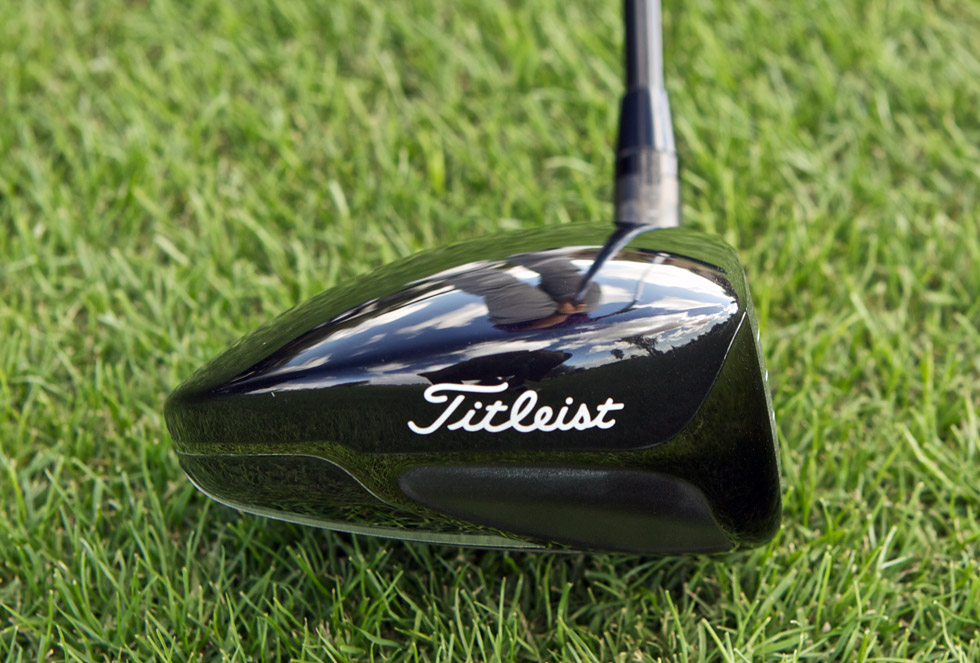
Forgiveness on off-center hits is improved over the driver I had previously. This is partly due to the deeper clubface – my previous driver was a bit shallower, particularly in the toe and heel. I’ve always liked a deeper faced driver as my misses tend to be up or down rather than towards the toe or heel. This driver performed incredibly well, particularly on shots caught high on the face. Balls struck high would carry a long ways and didn’t see enough spin loss to “float and fall.” Shots struck low had a slight propensity to balloon and lacked a little more ball speed than I’d like, but I believe the CG is a little higher in the 910D3 than the D2, and this would account for that – the sweet spot’s a little higher.
All told, the 910D3 rockets into a tie for first with the other adjustable drivers out there. What held it back before in the 909 series – adjustability – is now either best-in-class or tied for first. I think Titleist’s method for adjustments not only makes the most sense but offers the better improvements sought after by the skilled golfer. There’s no “adjust the face angle, which will affect both loft and lie in different ways depending on how a golfer adjusts his setup” with the 910D3 – just a straightforward series of adjustments to loft and lie with a consistent, square face angle.
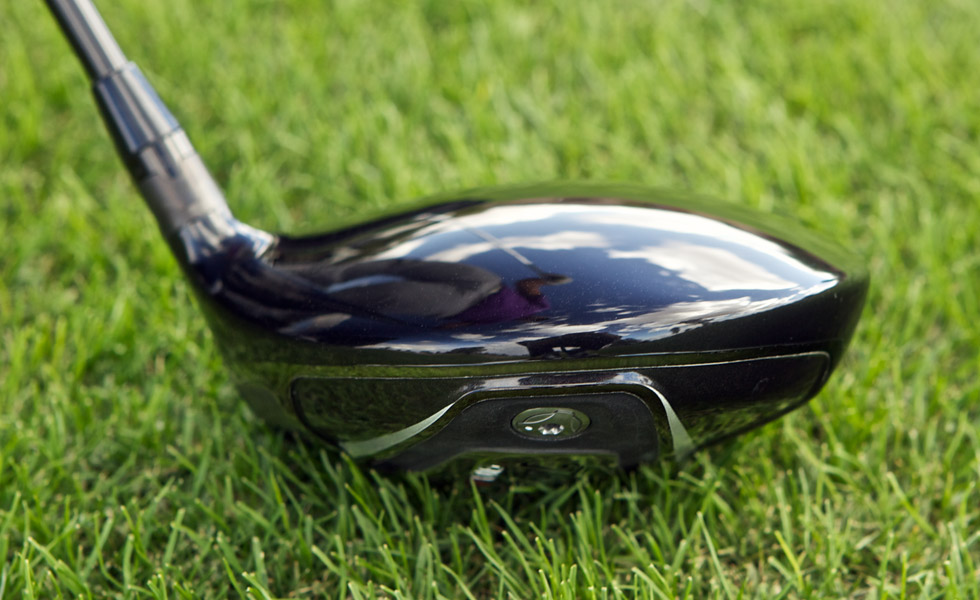
Specifications/Options
Three different proprietary Mitsubishi shafts (‘ahina 72, Kai’li 65, and ‘ilima 61) have the honor of being chosen as the stock shaft for these new drivers, all of which boast the Next Generation Diamana MDI (multi-dimensional interlay) technology. Each variation has a different bend profile and weight, further promoting the concept of finding you what fits. As if that weren’t enough, the Aldila RIP 60 and Project X Tour Graphite are also available as stock shaft choices, and they all come topped off with a Titleist Tour Velvet 360° rubber grip. If for whatever reason, one of those don’t appeal to you, over 80 different shafts are available from Titleist custom.
Both come with your choice of three lofts – 8.5°, 9.5°, and 10.5°. Included with each is a head cover and torque wrench (both seen below), as well as a lined valuables pouch, and foldout instruction booklet with a performance guide.
Also available separately for purchase is the SureFit Tour Weight Kit, which allows you to adjust the swingweight by changing out the screw weights. Each kit contains 2.5g, 7.9g, and 12g screw weights, along with a locking weight caddie and instructions for installation. The same SureFit Tour wrench that comes with the driver is used to swap weights.
Conclusion
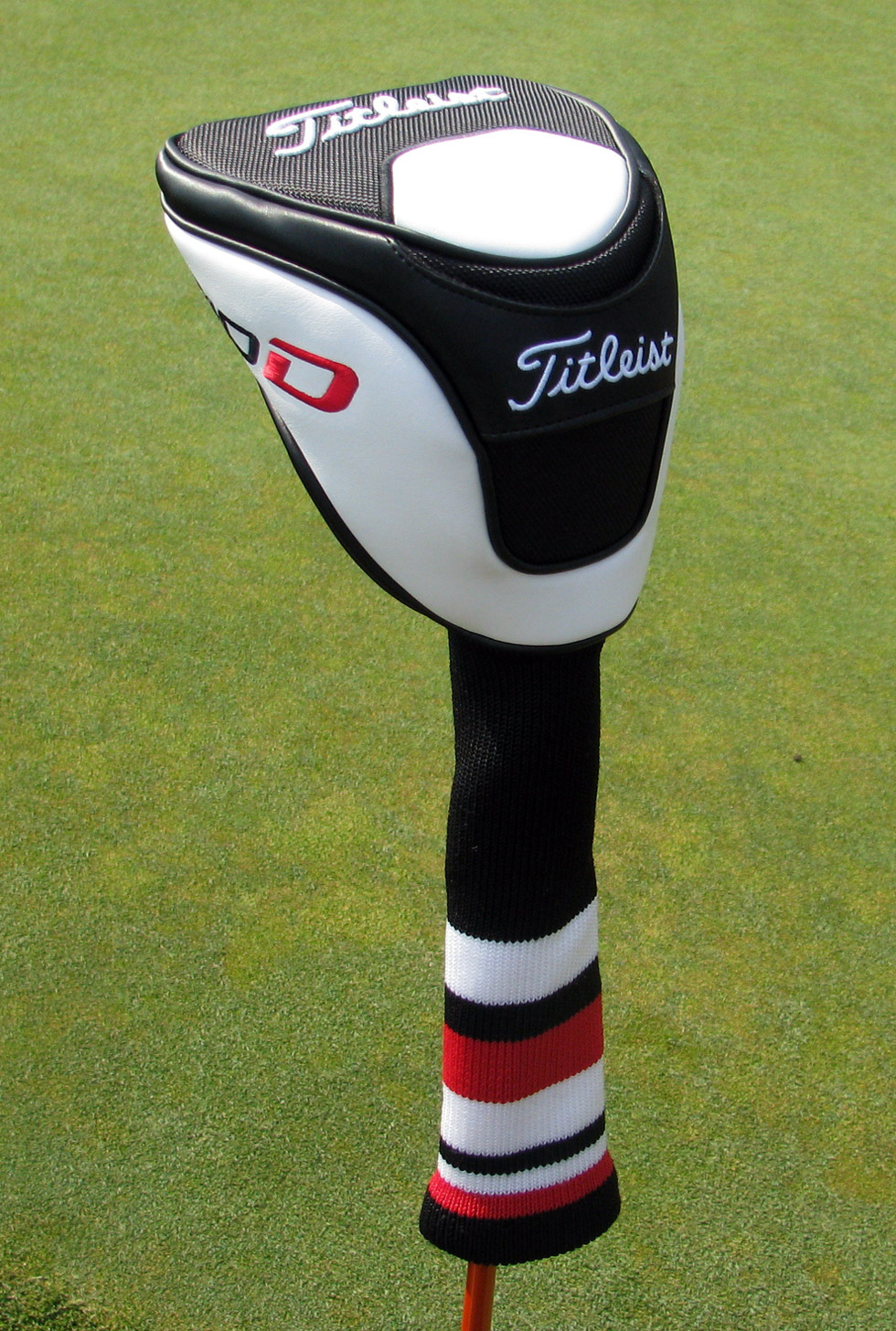 Though Titleist lagged somewhat behind, as the “traditional” minded company is wont to do, with the 907 and 909 drivers, the 910 series gives the company’s drivers (and fairway metals and hybrids) a kick in the pants and bumps them to the top of the heap.
Though Titleist lagged somewhat behind, as the “traditional” minded company is wont to do, with the 907 and 909 drivers, the 910 series gives the company’s drivers (and fairway metals and hybrids) a kick in the pants and bumps them to the top of the heap.
Good looks? Check. Great sound and feel? Check. Tradition with more than a sprinkle of cutting-edge technology? Check.
The 910D3 may not be the perfect driver for the mid- to low-handicapper, but in most cases making it so simply requires an adjustment of the SureFit Tour hosel.

Nice review, but I would have liked to see was a comparison between the 910 D2 and D3 drivers, the D3 driver might be a very nice tool in the hands of the very few near scratch players that have the abillty to work the driver.
Did you try the different swingweights and if so, what was the result ?
Besides that the Chart puzzles me….. I would expect a more upright lie to promote a fade instead of a draw …..
Gerald, I agree it would be nice, but in my experience Titleist is quite honest about the differences between their models. The 910D2 is a slightly larger head (460 vs. 445 cc), has slightly more spin, and a shallower clubface. Launch angle is a tad higher too.
I did not try the different swingweights. The results would have been fairly predictable. I prefer to choose the swingweight with which I’m comfortable and perform best and stick with it. 😉
Regarding the lie angle, imagine a perfectly fitted club at impact. Make the lie angle more upright and you can see how the face will point slightly to the left as the toe raises.
Great review and great club. I have an 8.5 d3 with a RIP 60…goes well.
Note that the face angle changes with loft adjustments. As you open the face opens, the loft is reduced. The face angle at A1 is .5 deg open, if you reduce loft the face opens to 1.5 deg. As you add loft the face closes. Try one and you will love it!
Personally, I wish Titleist offered a non-adjustable option in the 910 line, for the real traditionalists. Maybe I’m a grouch, but the adjustable hosel strikes me as “just one more thing that might break”. What I want is a totally neutral stick that is built to last.
i think this driver might be my gamer this year. Probably one of the best drivers Ive hit with the RIP shaft. R11 is good but IMO this one is alot better. You get quality with this driver.
I love the looks of this driver, especially the black face. The white clubs that have emerged this year isn’t as appealing to the eye. I’d rather drive a black car than a white.
One advantage with having an adjustable driver is that you can change the swing without having to change the club to achieve optimal launch conditions. A small swing change can change the launch angle with a couple of degrees. Adjusting the loft on the driver can help in getting the proper launch angle with the new swing. If you have a driver with a set loft, you may not get optimal launch angles if the swing change a bit.
If you are fit for the driver at handicap 20, swing changes dropping you to a 10 can make the loft not fit anymore. You can of course adjust ball position and tee height to accommodate for it, but that can in turn cause other problems.
Zeph,
I agree 100% about the appearance of this as opposed to the new white clubs you referred to. It’s too bad they went that way, as a couple of their recent models in the past couple of years were almost as good looking as these new 910 woods. Seeing these in person makes me want it regardless of how they perform (stupid thought, I know). They’re so clean and beautiful. From just an aesthetic standpoint, the entire 910 line of woods is by far the best looking Titleist has ever made, and I really hope others take note.
Thank you for this great review, I have always been a Titleist fan and currently own the 907 D1, I think it is time for an up grade.
I am a 3 handicap with 120 mph driver swing speed. Live in Colorado at 5500 ft elevation so the ball travels far. In CO I drive 310-350 yds and at sea level I drive around 290-320.
Just purchased a Titlesit 910 D3 8.5 deg with ahina x stiff 72 g, and set it on D1 (next to most fade setting) and about 7.5 deg loft. WoW!!! Great Driver. Distance similar to my previous Mizuno MP 600 8.5 x-stiff blue board, but the accuracy of the Titleist driver is much superior. I’m down the middle 1/2 time and down right side 1/2 time. Not a single snap hook which has been a previous problem for me once or twice a round. Temperatures have been in the 50-60s recently in Fort Collins, CO. Can’t wait in 1-2 months to see what the distance is like when it is 80+ degrees.
Driver feels great on impact, no goofy ping or clicking sounds, and sweet spot is fairly generous. If I hit my previous Mizuno driver in the sweet spot results were just as good. Mishits on Titleist do not seem to be that penalizing however compared to the Mizuno. I play Mizuno MP 68s and MPT10 wedges which I love and wanted to stay committed to a Mizuno driver, but after getting fitted by the Pro at my club the 910 D3 was just a great fit for me. I was also pleasantly surprised trying out the new Nike VR Pro driver. It felt great, but I did’t want a Nike club. I do however play Nike One Tour D golf balls which I’ve enjoyed and would say are very close, but not quite the equal of the Pro V1x.
I am confident that I could crush any new model of driver, but accuracy and dispersion are the most important features for me. On the D1 setting for the 910D3 driver I can play a slight draw, strait, slight fade, or big fade. Nearly impossible on that setting for me to snap hook it which for a big hitter is what you often worry about the most.
Hope this is helpful info.
Eric:
Thanks for your great reviews. Your review of the Mizuno MP-630 Fast Track driver had a lot to do with my purchasing one. Did the 910D3 knock the MP-630 Fast Track out of your bag?
Rick
rhan19, I still use both. I prefer the 910 just because the face is a teeny bit bigger, but the MP-630 still has a “softer” feel due to the shaft. So sometimes I like that one.
A note on grips: If you use a grip with alinement aids and then change the settings on the driver, the grip no longer lines up.
As i own the one of the white heads mentioned above, i think i agree, on sweetspot contacts i still think i have the best option ( tm R11 TP ) man
this club feels good, on the other hand if i don’t get it on the sweetspot i lose the forgiveness i was used to in my cobra S9-1. But for me i hit the center enough to like this one
but i have to say i like the white finish and the feel of my Taylormade, only thing i ajusted i use the open setting of the soleplate. I have the Aldila RIP 60 stiff shaft. And i love it.
Have about ten rounds under my belt with this driver — 8.5 with Project X shaft. I was fitted for this club and it seems to matter. I never would have looked at an 8.5* driver, but that is what the fitter said and I figured if he was wrong, I could adjust the loft to a 10. When the ball is hit, it stays hit a long time. Spin is great and the ball seems to cut through the wind better than anything I have played before. Some of the best drives of my life with this baby. Well hit balls are so good that I find myself choking up a bit to hit the sweet spot. Perhaps I should have gotten it a little shorter than standard. And again, the grip thing drives me a little nuts but for some reason I cannot bring myself to cut off a perfectly new grip just because it seems to be on twisted — see note above.
Absolutely love this club. When I bought it I had them set it on A-1 and I have not moved it. I’m hitting it so well I don’t want to mess with it. I went in with the thought of the Aldila shaft as I have had good success with those in the past but I tested the Diamana Kai’li and the results were great and most importantly, consistent. I don’t normally buy the latest and greatest but this was so good I couldn’t pass it up.
How do the chart / adjustments settings change for a 9.5 loft with regard to loft/lie ? Thanks
iam looking for screw in wieghts for the 910 titiest driver thanks